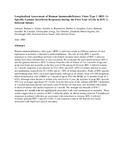| dc.contributor.author | Lohman, Barbara L | |
| dc.contributor.author | Slyker, Jennifer A | |
| dc.contributor.author | Richardson, Barbra A | |
| dc.contributor.author | Farquhar, Carey | |
| dc.contributor.author | Mabuka, Jenniffer M | |
| dc.contributor.author | Crudder, Christopher | |
| dc.contributor.author | Dong, Tao | |
| dc.contributor.author | Obimbo, Elizabeth | |
| dc.contributor.author | Mbori-Ngacha, DA | |
| dc.contributor.author | Overbaugh, Julie | |
| dc.contributor.author | Rowland-Jones, Sarah | |
| dc.contributor.author | John-Stewart, Grace | |
| dc.date.accessioned | 2013-06-30T12:20:40Z | |
| dc.date.available | 2013-06-30T12:20:40Z | |
| dc.date.issued | 2005 | |
| dc.identifier.citation | J. Virol. July 2005 vol. 79 no. 13 8121-8130 | en |
| dc.identifier.uri | http://jvi.asm.org/content/79/13/8121.short | |
| dc.identifier.uri | http://erepository.uonbi.ac.ke:8080/xmlui/handle/123456789/42956 | |
| dc.description.abstract | Human immunodeficiency virus type 1 (HIV-1) infection results in different patterns of viral replication in pediatric compared to adult populations. The role of early HIV-1-specific responses in viral control has not been well defined, because most studies of HIV-1-infected infants have been retrospective or cross-sectional. We evaluated the association between HIV-1-specific gamma interferon (IFN-γ) release from the cells of infants of 1 to 3 months of age and peak viral loads and mortality in the first year of life among 61 Kenyan HIV-1-infected infants. At 1 month, responses were detected in 7/12 (58%) and 6/21 (29%) of infants infected in utero and peripartum, respectively (P = 0.09), and in ∼50% of infants thereafter. Peaks of HIV-specific spot-forming units (SFU) increased significantly with age in all infants, from 251/106 peripheral blood mononuclear cells (PBMC) at 1 month of age to 501/106 PBMC at 12 months of age (P = 0.03), although when limited to infants who survived to 1 year, the increase in peak HIV-specific SFU was no longer significant (P = 0.18). Over the first year of life, infants with IFN-γ responses at 1 month had peak plasma viral loads, rates of decline of viral load, and mortality risk similar to those of infants who lacked responses at 1 month. The strength and breadth of IFN-γ responses at 1 month were not significantly associated with viral containment or mortality. These results suggest that, in contrast to HIV-1-infected adults, in whom strong cytotoxic T lymphocyte responses in primary infection are associated with reductions in viremia, HIV-1-infected neonates generate HIV-1-specific CD8+-T-cell responses early in life that are not clearly associated with improved clinical outcomes. | en |
| dc.language.iso | en | en |
| dc.title | Longitudinal Assessment of Human Immunodeficiency Virus Type 1 (HIV-1)-Specific Gamma Interferon Responses during the First Year of Life in HIV-1-Infected Infants | en |
| dc.type | Article | en |
| local.publisher | Department of Paediatrics, University of Nairobi, Nairobi, Kenya | en |
| local.publisher | Medicine, University of Washington, Seattle, Washington | en |
| local.publisher | Human Immunology Unit, Weatherall Institute of Molecular Medicine, Oxford University, Oxford, England | en |
| local.publisher | Human Biology, Fred Hutchinson Cancer Research Center, Seattle, Washington | en |

